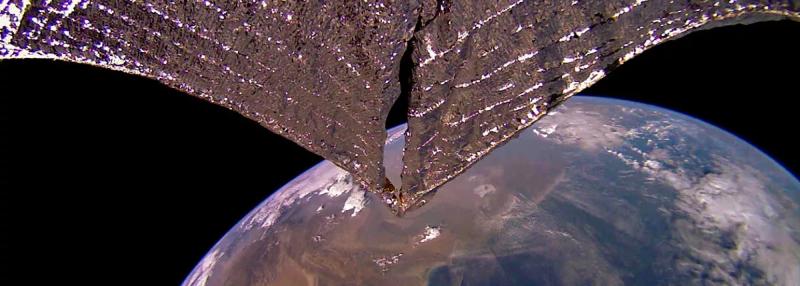 For several years, we have followed the Planetary Society‘s efforts to launch a solar sail that would be propelled by the light radiating from the Sun. In July 2019, the society’s LightSail 2 deployed a 32-square-meter solar sail, about the size of a boxing ring, in Earth orbit. Now 30 months later, LightSail 2 continues to sail on sunbeams.
For several years, we have followed the Planetary Society‘s efforts to launch a solar sail that would be propelled by the light radiating from the Sun. In July 2019, the society’s LightSail 2 deployed a 32-square-meter solar sail, about the size of a boxing ring, in Earth orbit. Now 30 months later, LightSail 2 continues to sail on sunbeams.
LightSail 2 is the first spacecraft in Earth orbit to be propelled only by sunlight. The craft orbits the earth powered by the momentum of solar photons striking the sail.
SciTechDaily reports that the Planetary Society, whose members funded the $7 million mission, said it shares mission data with NASA to assist three upcoming solar sail missions: NEA Scout, Solar Cruiser, and ACS3. NEA Scout is scheduled to hitch a ride to lunar space as early as February 2022 on NASA’s Space Launch System rocket during the Artemis I test flight. The mission will use its solar sail to leave the vicinity of the Moon and visit an asteroid.
Solar sails use the power of photons from the Sun to propel spacecraft. While photons have no mass, they can still transfer a small amount of momentum. So, when photons hit the solar sail, the craft is pushed very slightly away from the Sun. Over time, if a spacecraft is out in space without any atmosphere to encumber it, it could potentially accelerate to incredibly high speeds.
A spacecraft with a solar sail wouldn’t need to carry fuel and so could theoretically travel for longer periods of time, as it wouldn’t need to refuel.
But LightSail 2 is in orbit around the Earth. As the spacecraft swings its sails into the sunlight, it raises its orbit by as much as a few hundred meters a day. But the small spacecraft doesn’t have the means to tilt the sails precisely enough to prevent lowering its orbit on the other side of the planet. Eventually, LightSail 2 will dip far into the Earth’s atmosphere to succumb to atmospheric drag. It will deorbit and burn up. Mission engineers estimate the spacecraft could stay in orbit for at least another year.
Planetary Society Deploys LightSail 2’s Solar Sail. What Does The Future Hold For Solar Sails?

Heavily blasted by ionic oxygen but still in the running. 🙂
So basically as it stands now the orbit becomes more and more elliptical? Just begs for a follow-on with reaction wheels to so as to be able to tack and gybe.
Thanks for the update!
Presumably it only sails downsun and when the sun is forward of the beam it acts as a brake.
I am guessing it winet half way around the earth and became stationary trying to come out on the other side.
went
Just a hunch. In the attempt to create a light duty probe, they went too light. That when the sail was deployed it was set in solar concrete. That what ever team had thought the deployment module was going to apply torque to the sail and reorient the sail to the wind. The first image we see could very well be from the team attempting to torque the sail.
Now all they have is a camera that they can orient some what to take earth pictures (oor even space debris)